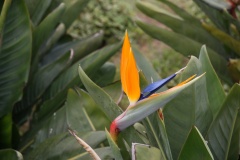Bird-of-paradise
| Infobox on Bird-of-paradise | |
|---|---|
| Example of Bird-of-paradise |  |
| Facts | |
| Origin | - |
| Stowage factor (in m3/t) | - |
| Humidity / moisture | - |
| Ventilation | - |
| Risk factors | - |
Bird-of-paradise
Contents
Description
Scientific name and introduction
Strelitzia reginae. The bird-of-paradise inflorerscence consists of a boat-shaped bract containing a series of 4 or 5 flowers, so when an exposed flower withers, another one can be pulled out. Few cut flowers have this capability. Growers bag the inflorescence a few weeks before harvest. Slender, elongated waxed paper bags are placed over the expanding bracts a week or more before the orange flowers are ready to emerge. The bags protect the brittle flowers by holding them inside or next to the bracts. The bag also helps prevent Botrytis mould, rain and hail damage, aphid attacks, and sunburn of the flowers. The specific epithet reginae means ‘queen’.
Quality characteristics and criteria
Inflorescences bend as they reach maturity, assuming a 90° angle to the stem. The first emerging orange flowers can barely be seen through the paper bags. The stems are pulled at this point. Stems can also be harvested in the tight bud stage before the first flowers emerge. At this stage the inflorescence is swollen, and there is a slight orange crack on the upper surface. The inflorescence is mature at the tight bud stage and is at the optimum stage for harvest, from the point of view of ease of handling and flower longevity. Make sure flower heads are dry at time of purchase. If flowers are wet or have excessive nectar exudation upon unpacking, then the possibility of subsequent disease problems is increased.
Grading and bunching
Strelitzia stems are sorted into at least 3 grades according to stem length and inflorescence size. For premium grade flowers, the field bags are replaced with new bags. Five stems are firmly tied together at 2 points with the inflorescences facing in the same direction. The stem ends are evenly trimmed. A paper wrapper is placed around the bunched inflorescences to further protect the flowers.
Ethylene sensitivity
Strelitzia flowers are insensitive to ethylene and their life is not improved by treatment with STS or 1-MCP.
Pretreatments
Flower longevity can be substantially increased by pulsing buds or flowers for 24 h.rs. (48 hrs. is even better) with a solution containing 10% sucrose, 250 ppm 8 hydroxyquinoline citrate (8-HQC), and 150 ppm citrate.
Storage conditions: The optimum long term storage temperature range for this species is 6° to 7°C, which is different from most other flowers. Storage below this recommended range can result in chill disorders, the appearance of brown lesions on the flowers and bracts, and the failure of the flower to open properly. For short-term storage, hold the flowers at room temperature, or in a tropical storage room at 12,5°C. Strelitzia flowers harvested in the tight bud stage will open and have satisfactory vase-life after 4 weeks in storage if pre-treated with a fungicide, wrapped to prevent desiccation, and stored at 7°C and 85% to 90% RH.
Packing
Waxed paper bags on each inflorescence and the paper wrapper on each bunch give ample protection from handling injury and desiccation. Because they are very heavy, Strelitzia stems should be packed in shallow cartons.
Special considerations
If flowers do not emerge from the spathe (modified leaf below flower), the first flower can be gently eased out by hand and will normally provide good display life.











